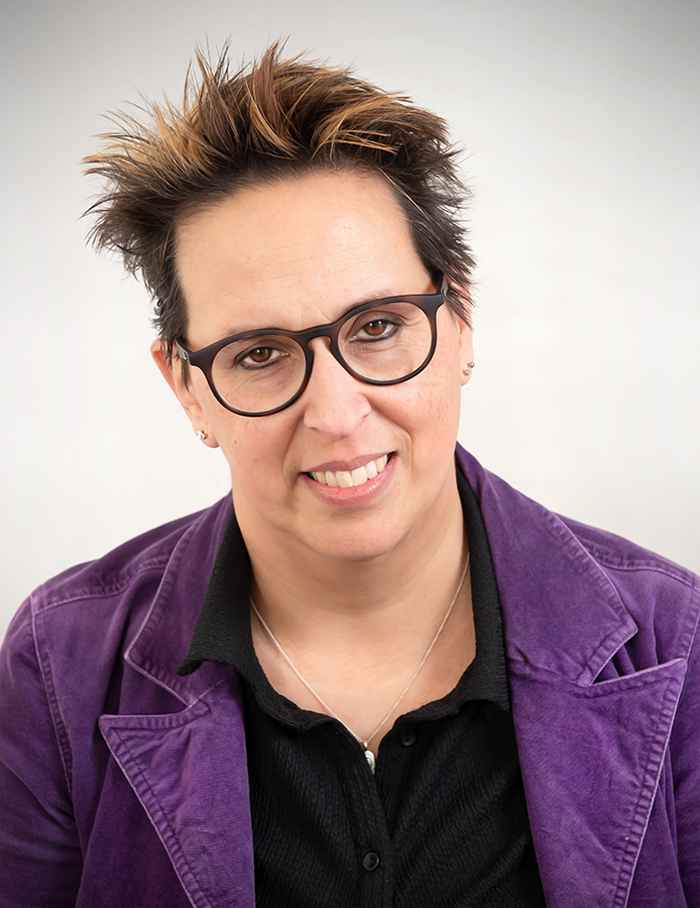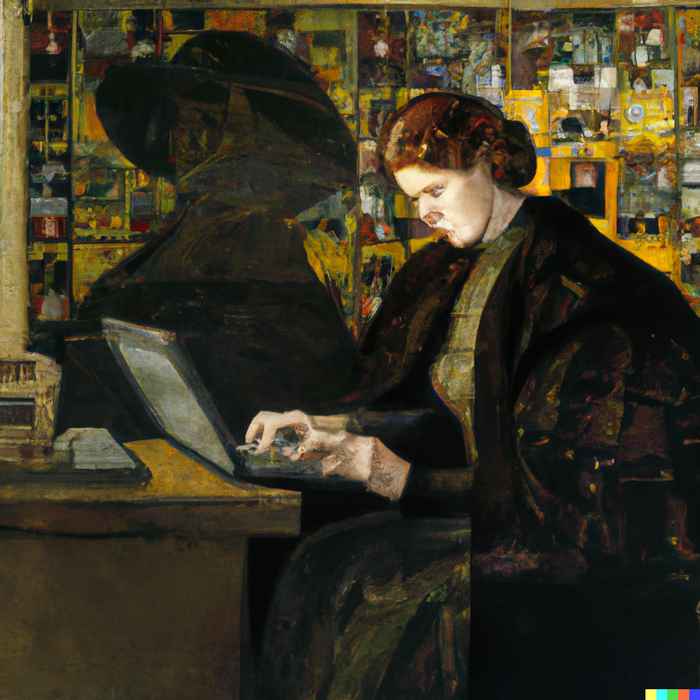Bringing Information Technology and Content Closer Together
UvA/HvA Library in Digital Transformation
17 February 2023

In the fall of 2022, Marjolein Beumer started as head of Digital Projects & Innovation at the University of Amsterdam (UvA)/Hogeschool van Amsterdam (HvA) Library. According to her, both a digital transition and a digital transformation are needed within the organization's digitization process. 'The digital transition means that we must first be digitally up-to-date ourselves and that internal processes are adapted to this. The digital transformation is the process of innovation and disruption of the organization. This can involve the use of new technologies to achieve organizational goals. Think of using artificial intelligence (AI) to unlock data.'
Digital transformation means adapting to the changing environment, she explains, and also thinking about continuity: where will the organization be in ten years? 'In this last phase, you use new technologies to design a business model that can offer additional or new customer value. The question then is: what services can you provide that fit with the changing world and the desires and needs of your target groups?'
Renewing work processes
The Library must find a new place and role, says Beumer. "It takes time to find out what the desires and new questions of our target groups are. Both in the transition and in the transformation, the organization is still searching. We want to connect research, education, and heritage. The common denominator of these three is data, so the questions that arise are: how do you create, unlock, and use data, and how do you present and archive it?"
To be able to respond well to the new questions that arise from research, education, and heritage, the organization must first be up-to-date itself, she continues. 'We will renew our work processes for this purpose and train our employees to look at things in a different way and to work with new digital techniques. Because only if we can do it ourselves, can we support our target groups well.'
In 2021, the Library made a substantial budget available to improve the digital skills of employees, such as on linked open data, data modeling, Knowledge and Data (at VU), Wikidata, and dealing with algorithms and AI within government. 'Many people have taken advantage of this. There is a great desire to learn new things. When I offer a workshop or symposium on digitization or AI, colleagues are very enthusiastic. The risk of voluntary participation is that some will soon know a lot and others will lag behind. In collaboration with our Digital Competencies department, I want to ensure this year that everyone has the same basic knowledge on topics such as AI and data management. In addition, employees can see for themselves where they want to deepen their knowledge further from their position and can seek advice from our internal training coordinator.'
Another part of the transition is that the Library is going to work more data-driven, explains Beumer. 'We are looking at what we can learn from analyses of organizational statistics. The idea of data-driven work is not new, but there are now a lot more digital data available, making it easier to really get started with it. It leads to a new way of thinking. "If I am going to do something, what am I basing it on and why am I doing it?" Data provide insights into the needs of your target groups and help make choices in innovation.'
Digitization and Provenance Research
The Allard Pierson, which shares the heritage collections of the University of Amsterdam with the academic community and the public, is also working hard on the digital transition. Part of the objects has already been digitized. 'The image bank contains about 40,000 digital images with descriptions,' says Beumer. 'However, the collection is much larger and new collections are still being added. This year, we are taking a big step in unlocking and digitizing the collections. One of the reasons is the Provenance Research project. For objects acquired after the 1970 UNESCO Convention, we need to know where they came from and whether they were legally obtained. For a part of the archaeological collections, this is not clear. Sometimes we don't know who purchased the object in question, and sometimes it is a gift from a private collector and we don't know how they obtained it. We will ensure that images and descriptions of all objects acquired after 1970 are available online, and we will be transparent about what we know about their origin.'
The (im)possibilities of AI
Together with Heleen Wilbrink from the company Aincient, a specialist in AI applications for heritage, Beumer recently conducted research on the possible applications of AI for the Library. 'We asked thirty people inside and outside our library, "Where do you see possibilities or needs to apply AI in your field of work?"'. The first thing many people said was, "I know too little about AI to be able to say anything about it." However, they often turned out to have had some exposure to it. Artificial intelligence appears to be a difficult and elusive topic for many.
This month, based on the research, Wilbrink will produce a paper on what AI actually is, what the challenges are for libraries, and how AI can be applied now or in the future within the University of Amsterdam/Hogeschool van Amsterdam Library. "The paper will also provide practical tips on how to start applying AI in research, education, and heritage," says Beumer. "It will be the basic AI course for our library staff. The goal is to get everyone thinking about the question: How can I apply AI in my field of work? This can range from faster metadata of collections to handwriting recognition." The Digital Projects & Innovation team is also exploring what the Library can contribute to the AI research being conducted within the University of Amsterdam and Hogeschool van Amsterdam.
Required transparency
The paper will certainly also address what is necessary for a responsible deployment of AI, Beumer explains. 'The Library is the guardian of knowledge and resources, so we must be able to inform and advise our target groups well on the advantages and disadvantages of AI, such as bias. We see that many researchers are not yet so digitally skilled, and even researchers who program themselves are not always aware of the possible negative consequences of AI. Responsible use of this technology requires transparency about the data and algorithms used. When you use AI, you sometimes do not know the sources of the information. At the same time, in research and education, we are increasingly working more openly and bias and discrimination are detected earlier than before, when only a limited group of people could read scientific publications. Thanks to digital access, these articles can now be consulted globally.'
Interdisciplinary approach and connection
The Library is a knowledge hub and can take an interdisciplinary approach and make connections between faculties, Beumer states. Her team Digital Projects & Innovation is now mapping out what new digital developments there are and what support the Library could provide in connection with what is happening in research and education. 'We do this together with the library colleagues of Research and Education Support. They are in contact with researchers, teachers and students. The information specialists of the Library and the data stewards at the faculties identify needs and questions. If they don't have a solution, those questions come to our team. We then outline the problem and the possible technical solutions, which can lead to an innovation pilot.'
At the moment, Beumer is conducting preliminary research for an innovation pilot. 'We receive many requests from researchers who have created a database for their research, often linked to a website or app, which allows other researchers and citizen scientists to conduct research and add data or information. When the research project and funding are completed, it is important to maintain such a database. However, there are still no digital technical solutions and resources for this, even nationally. We are now investigating with these researchers what is exactly needed and trying to determine what our role could be in this. Should the Library host and manage such 'living' databases, or should it only advise on a solution? This is a current example of the digital transformation in which the collaboration with and the needs of researchers are central.'
Linked open data for research data
Another pilot project in 2022 involved making the datasets of three cultural research programs available for (re)use by everyone in the long term, using linked open data (LOD) in collaboration with the UvA CREATE Lab. The project was nominated for the Dutch Data Prize 2022. The three programs are Cinema Context (an online encyclopedia of Dutch film culture from 1896), ONSTAGE (about the Amsterdam public theater from the seventeenth century to the present day), and ECARTICO (biographical data about cultural entrepreneurs in Amsterdam from the fifteenth to the eighteenth century). According to Beumer, 'With such a pilot project, we learn a lot about the required (meta)data quality and how to improve it. We are now exploring whether the LOD service for research databases can become a permanent library service. If research data becomes widely available via LOD, it can be combined with external data and the data from the library catalog and the twenty linked open datasets of the Allard Pierson. So when you search for "Shakespeare," you can find films, books, performances, prints, theater reviews, and so on about Shakespeare.'

Personalized searching in collections
'The beauty of digitization is that collections become more visible and usable for researchers, heritage professionals, citizen scientists, and students, but also for museum visitors,' says Beumer enthusiastically. 'It is often thought that if you digitize collections, no one will come to the museum anymore, but the opposite is true. People want to see the objects in real life.' Beumer, who has about twenty years of experience in digital innovation and heritage, has been working for the Allard Pierson on the Creative User Empowerment project since 2021. 'In this project, we are investigating with the Badisches Landesmuseum (BLM) in Karlsruhe how we can use AI to make heritage collections more searchable and personalized. We use the datasets of both museums, which also have substantive similarities. Both, for example, contain Art Nouveau collections.'
It is her dream to enable personalized searching in collections, says Beumer. 'Allard Pierson and BLM are working together on an open-source tool called xCurator, which applies AI to allow users to search the datasets of these two museums in a personalized way, combined with external sources such as Wikipedia and the Art & Architecture Thesaurus. So far, you could only search for the keyword that is in the database. If you use AI, the computer can think along with you, remember your interests, and show you things you didn't even know you were looking for.'
Associative searches
Artificial intelligence enables associative searches, Beumer continues. 'In this way, you could start with an Art Nouveau object from the BLM collection and end up with a poster from the Delftsche slaolie-fabriek (which is known for its Art Nouveau advertising material, created by artists such as Jan Toorop). Then you could find a research paper on peanut plantations, as the same manufacturer also makes peanut butter alongside its oil. We want to combine techniques such as semantic search and image recognition in the xCurator tool. By connecting these collections with external sources, new insights and stories can emerge. xCurator users can then create a digital exhibition or publication as a curator, which can be added to the collections.'
Creating and transferring new knowledge
By bringing digital applications and content closer together, Beumer aims to create and transfer new knowledge. 'We have very diverse heritage collections - from maps, computers, church history, and natural history to Jewish cultural history and a library collection of theses, dissertations, journals, and more. There is so much knowledge hidden in there! Imagine connecting all that knowledge and making it searchable at once. That can lead to many new insights and new stories.'

The library, like many others, needs to reassess and reaffirm its position, role, and significance. In the coming years, we will focus on a digital transition and digital transformation, in which we seek a balance between physical and digital services for education and research.Gerard Nijsten, director of the UvA/HvA Library
In addition to digitization, physical locations of museums and libraries remain just as important, she concludes. "There is nothing more enjoyable than walking through a museum or library and looking at the objects up close, almost being able to touch them and smell them." This is why the new Library of the UvA is being built behind the Allard Pierson, where we will bring together physical and digital resources.
This interview was written in Dutch by Anneke de Maat, and edited and published by InformatieProfessional (the digital edition of 14 February 2023). This English version of the interview was made by ChatGPT.